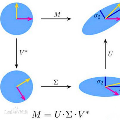Learning efficient graph representation is the key to favorably addressing downstream tasks on graphs, such as node or graph property prediction. Given the non-Euclidean structural property of graphs, preserving the original graph data's similarity relationship in the embedded space needs specific tools and a similarity metric. This paper develops a new graph representation learning scheme, namely EGG, which embeds approximated second-order graph characteristics into a Grassmann manifold. The proposed strategy leverages graph convolutions to learn hidden representations of the corresponding subspace of the graph, which is then mapped to a Grassmann point of a low dimensional manifold through truncated singular value decomposition (SVD). The established graph embedding approximates denoised correlationship of node attributes, as implemented in the form of a symmetric matrix space for Euclidean calculation. The effectiveness of EGG is demonstrated using both clustering and classification tasks at the node level and graph level. It outperforms baseline models on various benchmarks.
翻译:学习高效的图形表示法是顺利处理图表上下游任务的关键,例如节点或图形属性预测。鉴于图形的非欧洲结构属性,保存原始图形数据在嵌入空间中的相似性关系需要特定工具和相似度度度度。本文件开发了新的图形表示法学习方案,即EGG,它将大约的二阶图形特性嵌入到格拉斯曼方块中。拟议战略利用图图变来学习图的相应子空间的隐性表示法,该小空间随后被映射到通过流出单值分解(SVD)的低维元的格拉斯曼点。既定的图形嵌入图约为节点的分解关联性,以对齐矩阵空间的形式用于计算Euclide值。EGG的有效性通过在节点层和图形层面的组合和分类任务得到证明。它比各种基准的基线模型要差。



